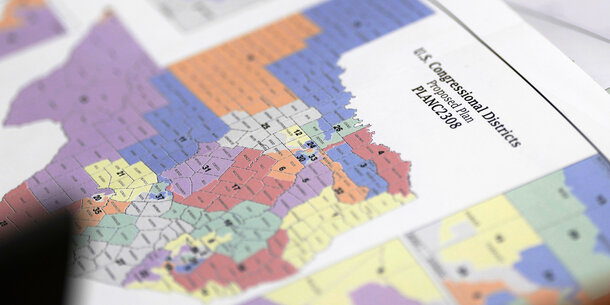Every 10 years, states redraw their legislative and congressional maps. The process, which is now underway all across the country, is supposed to be fair and ensure equal representation for all. But too often the process is hijacked by political parties who draft unfair maps meant to consolidate their grip on political power — both in statehouses and Congress.
Partisan gerrymandering, as it’s known, disfigures our democracy by making elections uncompetitive and by diluting many communities’ political power, particularly communities of color. This month, the Ohio Redistricting Commission, on a 5–2 party line vote, gave us a master class in how to achieve a one-party state when it approved new legislative maps. That’s why the Brennan Center and co-counsel at Reed Smith filed a lawsuit Monday to force the commission to redraw these maps.
We’re representing the Ohio Organizing Collaborative, CAIR-Ohio, the Ohio Environmental Council, and numerous Ohio voters. We argue that the commission’s gerrymandered maps flagrantly violate numerous rights guaranteed by the Ohio Constitution and have asked the Ohio Supreme Court to order the commission to redraw these blatantly unfair district lines.
The partisan maps, which not one Democratic member of the commission approved, entrench a Republican supermajority in the Ohio General Assembly. But what makes this act of partisan gerrymandering so egregious is the sheer antidemocratic chutzpah of the state’s redistricting commission. In 2015, 7 out of 10 Ohio voters approved an amendment to the state constitution to encourage bipartisanship in the redistricting process and explicitly outlaw partisan gerrymandering. The amendment established a bipartisan redistricting commission that would draw fair state legislative maps that don’t “favor or disfavor a political party” and ensure that the composition of the legislature corresponds closely to the statewide preferences of Ohio voters.
The redistricting commission failed to even pursue bipartisan cooperation and completely ignored those clear fairness standards, and by doing so, drew maps that not only assure Republican veto-proof control of government but also particularly burden communities of color. The commission’s members did this by engaging in two tactics: cracking and packing. In some places, the district boundaries were drawn to split, or crack, Democratic voters into two separate districts to reduce their chances of winning these elections. In other places, the commission crammed, or packed, Democratic voters into a few districts to minimize the number of districts where the Democratic Party might win.
Not surprisingly, the commission cracked and packed many of Ohio’s Black and Muslim residents in gerrymandered districts, which would result in less representation in the state’s general assembly. One of our plaintiffs, Pierette Talley, explains: “If the maps remain in place, millions of Ohioans, particularly Black Ohioans and other people of color who live in these gerrymandered communities like Toledo, won’t have a voice in any policies impacting their lives that come out of the Columbus statehouse.”
America’s multiracial future is already here. Partisan gerrymandering, like the maps drawn by the Ohio Redistricting Commission, strangles it before we can make it a reality politically.
Ohio won’t be the last state to draw unfair maps. Watch this space: as more and more states draw their maps for the next decade, the Brennan Center will stay vigilant against partisan gerrymandering and discrimination.



